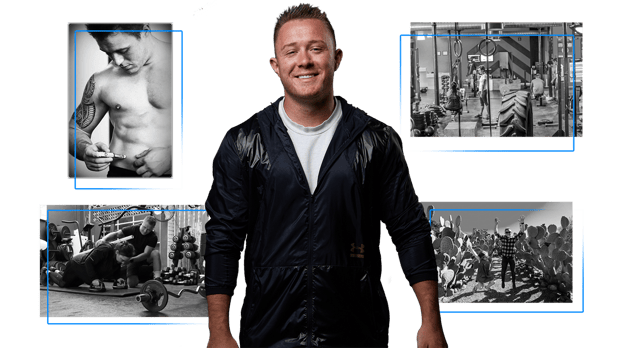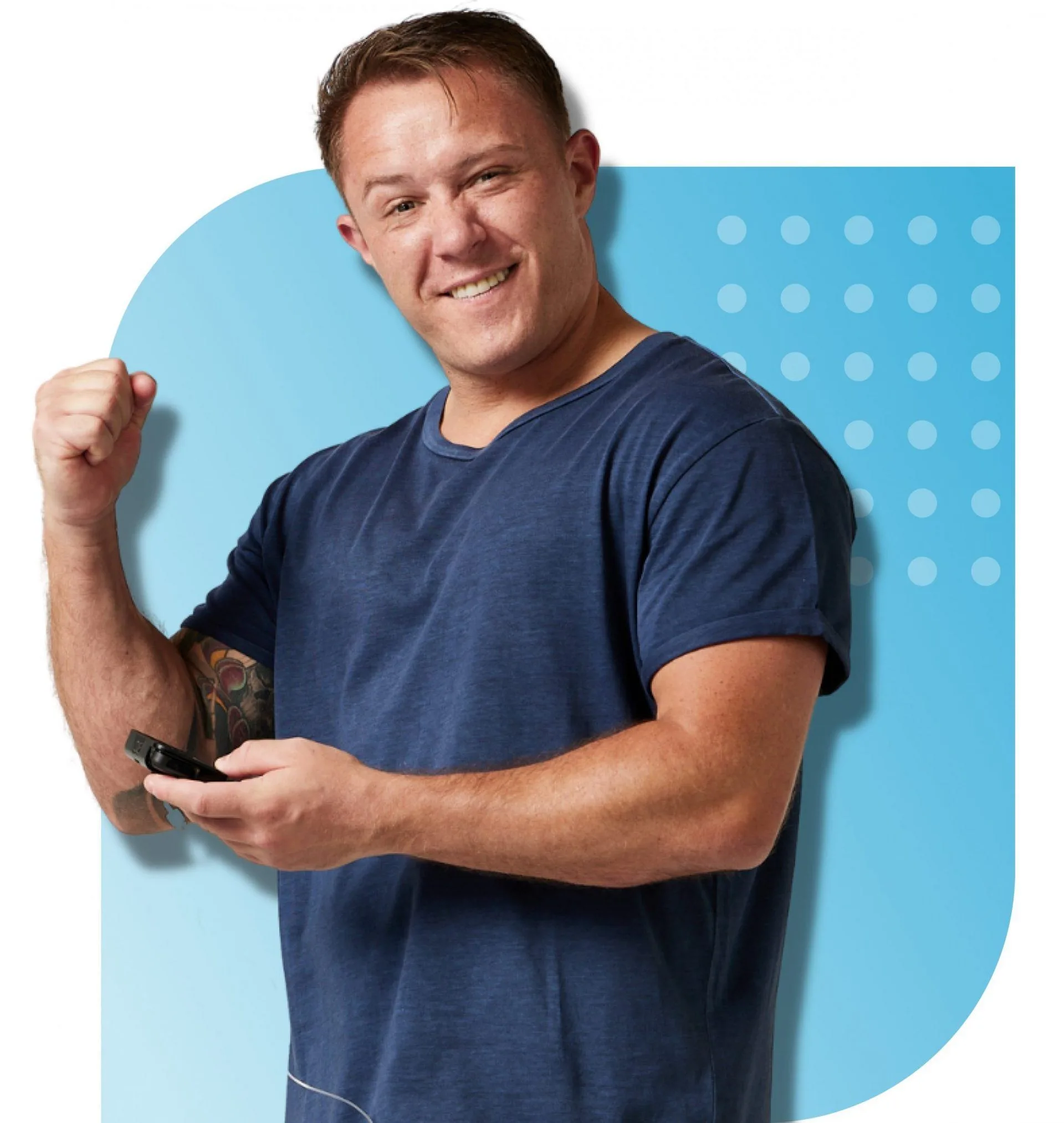What does it feel like to be diagnosed with diabetes? And is there a way to turn this kind of diagnosis into something positive? For Nicholas Caracandas, the answer was learning to own it as part of his identity. After being diagnosed with Type I Diabetes about 30 years ago, he figured out how to help other T1Ds achieve their exercise and nutrition goals and ultimately self-manage their diabetes. Nicholas shared his insights with Longevity for Wellness Wednesday
Manage your diabetes successfully
A certified nutrition coach and personal trainer, he has lived with diabetes for over 30 years. Today, he runs a successful diabetic fitness and lifestyle coaching program called Diabetic Athletic, designed to help T1Ds achieve their exercise and nutrition goals and ultimately self-manage their diabetes.
Nicholas lives in Cape Town with his wife and daughter. Speaking to Longevity for a Wellness Wednesday session, Nicholas shared his tips on how T1Ds can start/excel at exercising while ensuring they manage their insulin and blood sugar levels.
“We believe that diabetes is a skill, and we work to teach that skill,” he says. “Our aim is to change the way we look at this disease. We want to see it as the reason that we reach our full potential – not the reason that we don’t. As you may know, living with diabetes can be very difficult at first. Also, many of the roadblocks that we all face are very similar.”
Nicholas explains that it starts with figuring out what we want to do in our everyday life. Now, this is a challenge everyone faces, not just people with diabetes. However, diabetics have the additional difficulty of having to manage the glucose levels in their bloodstream.
“I’m really the guide that kind of puts what you were going to do together with what you can be when diabetes really isn’t in the way,” he says.
You’ve been given a diagnosis, now what?
Nicholas’ first experience of diabetes came from his mother having the condition. “I would see my mom try to deal with her diabetes, but very much in the shadows. You know, often when we get diagnosed with something like diabetes, we don’t really come out and be very open. It rather becomes a part of our identity that we kind of keep to ourselves because we’re trying to figure it out. But as someone who has been diagnosed with the disease, the biggest step you can take is to own that as a part of your identity. That’s really the fast track to just taking charge of your own life and your future.”
He remembers seeing his mother check her sugar levels and taking insulin twice a day. At the time, he thought that was all there was to it. He didn’t realize that his diagnosis would require every thought from there on forward to take his glucose levels into account.
“It’s like trying to juggle six balls all of a sudden,” he says. And it’s clear this disease has a profound impact on those who live with it, and the number of this group seems to keep growing.
According to Statista, 537 million people are currently living with diabetes all over the world. By 2045, projections show this number rising to some 783 million globally. The WHO explains that there are 9 million people living with Diabetes Type 1. The mental load of the condition is often underestimated, but it can place an immense strain on the person who has it.
 Understanding diabetes burnout
Understanding diabetes burnout
“Because diabetes requires an immediate and long-term change in how we think, act, and move on a daily basis, it has a profound effect on our mental health,” Nicholas explains.
“This causes the brain to take a hard knock. Also, having to do so much, and not knowing what to do can often lead to a very common complication. This is called diabetic burnout. It can happen at any time.”
Medical News Today agrees. According to the website, diabetic burnout usually happens when the diabetic person starts having difficulty dealing with the demands, strict self-management, and extensive medical regime placed on them. These conditions can cause them to start feeling emotionally and mentally drained, overwhelmed, exhausted, or disillusioned from living with and managing diabetes. If they feel unable to cope with their diabetes management, they may even disengage from their diabetes care.
The Centers for Disease Control and Prevention (CDC) states that it can be helpful for a person experiencing diabetes burnout to consider the following:
- Involve the health care team: Whether that be a person’s primary doctor, consultant, optometrist, or nurse, these professionals are there to help. As well as reminding a person of the progress made with their diabetes management, they can also help with new strategies in managing diabetes.
- Remember that perfection is impossible: Diabetes can be an unpredictable condition, and this can make management difficult. When it comes to treatment goals, a person should try to break them down into small steps. For example, instead of aiming for a specific target A1C range, a person can focus on lowering their A1C by 1%.
- Lean on the community: Living with diabetes and diabetes burnout may feel isolating. There are a number of diabetes forums and support groups where people share similar experiences. These supportive environments can create a place for people to feel heard and share advice.
The stronger you are, the better you can function
In the Diabetics Athletics program, exercise features prominently. As Nicholas puts it, the stronger you are, the more effective you are at everything.
“One of the biggest misconceptions [we encounter] is that exercise is about six packs and earning our food. Strength is pretty much the most important aspect of our physical existence. [Likewise], a lack of strength compromises performance and quality of life as we age. Furthermore, diabetes is a progressive condition and so is ageing. As people living with diabetes, we really must possess a great deal of physical and mental strength. [In the program], exercise is both the fountain of youth and a way to ease diabetic management.”
It’s about building
Nicholas tries to focus less on limiting calories and more on creating stability in the blood sugar. For him, it’s not about eating less and exercising more, but fueling the body so that muscle gain can happen. This means making sure there is the right amount of fats, carbs and proteins. “After all, the best fat loss program is a muscle gain program.”
Remember that prevention is better than cure
While TD1 is often genetic, lifestyle choices often play an important role in the development of TD2. Dr. Zaheer Bayat is a physician, endocrinologist, and Chair of the Society for Endocrinology, Metabolism, and Diabetes of South Africa (SEMDSA) as well as Head of Internal Medicine at Helen Joseph Hospital. According to Dr. Bayat, there are three key tips that can have a big impact on lowering your risk for TD2:
1. Eat healthy foods
Choose foods lower in fat and calories and higher in fiber. Focus on fruits (in moderation), vegetables, and whole grains.
2. Get more physical activity
Try to get about 30 minutes of moderate aerobic activity on most days, or at least 150 minutes a week. For example, take a brisk daily walk. If you can’t fit in a long workout, break it up into smaller sessions throughout the day.
3. Lose excess kilos
If you’re overweight, losing even 7% of your body weight can lower the risk of diabetes. For a person weighing around 90 kg, even a 6 to 7 kg weight loss can significantly lower your risk of developing type 2 diabetes.
Top tips to reduce your sugar intake:
- Avoid soft drinks and other sugar-sweetened beverages. These are among the top sources of added sugars.
- Reach for fruit instead of sweets, chocolate, biscuits, or other sweet treats.
- Read the ingredient labels. Sugar is often hidden in places you wouldn’t expect, such as pasta sauces and sandwich bread.
- Added sugars have a lot of different names, which are typically not easily understood. When reading labels, keep an eye out for terms like corn sweetener, corn syrup, dextrose, fructose, glucose, high-fructose corn syrup, honey, lactose, malt syrup, maltose, molasses, raw sugar, and sucrose.
WATCH THE INTERVIEW
For more on the discussion. Watch the interview below.
View this post on Instagram
References
CDC: https://www.cdc.gov/diabetes/library/spotlights/diabetes-burnout.html
World Health Organisation: https://www.who.int/news-room/fact-sheets/detail/diabetes
Statista: https://www.statista.com/topics/1723/diabetes/


